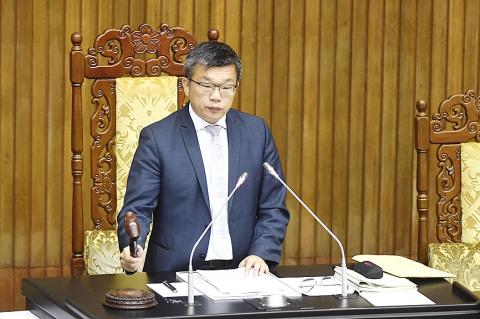The Legislative Yuan at an extraordinary session yesterday passed a third reading of draft amendments to the Act Governing Relations Between the People of the Taiwan Area and the Mainland Area (台灣地區與大陸地區人民關係條例) that could see the monthly pensions of retired officials or military officers revoked for engaging in behavior that “impairs national dignity” at celebrations or events hosted by the Chinese Community Party, the Chinese government, or China-based military or political groups.
Such behavior includes saluting the Chinese national flag or emblem, and singing the Chinese national anthem, according to the draft amendments.
The amendments were proposed after 32 retired generals in November 2016 attended an event in China marking the 150th anniversary of the birth of Sun Yat-sen (孫中山), at which they listened to Chinese President Xi Jinping (習近平) give a speech and stood during a rendition of the Chinese national anthem.

Photo: George Tsorng, Taipei Times
In a version of the amendments that passed a preliminary review, only the retired heads and deputies of government agencies associated with national defense, foreign affairs, China affairs and national security; retired heads of intelligence agencies; and retired officers ranked lieutenant general or above would be subject to the restrictions.
However, before a vote in the second reading, the Democratic Progressive Party (DPP) caucus proposed a revision motion to have the amendments apply to retired officers ranked major general and above, and to expand the restricted area beyond China.
The penalties were also raised from the amount that the DPP caucus originally proposed.
In the revised version, which passed yesterday, offenders could lose half to all of their monthly pensions for five years, as well as their medals, military orders, licenses and certificates.
Severe breaches could result in the permanent cancelation of monthly pensions, or the return of payments that have already been made.
Offenders who opted for a one-time pension payment would be fined NT$2 million to NT$10 million (US$64,247 to US$321,234).
Whereas three years was the “standard” time frame for travel restrictions, with government agencies reserving the right to extend or shorten that period, the passed version makes three years the minimum, and only allows agencies to prolong, but not shorten, the restrictions.
To avoid confusion over the words “national secrets” in the act, which some had interpreted as only referring to “classified national security information” regulated by the Classified National Security Information Protection Act (國家機密保護法), the amendments have changed the words “national secrets” to “national security, interests or secrets.”
Under current regulations, the mayors, county commissioners and government officials would need the approval of the Ministry of the Interior, in conjunction with the National Security Bureau, the Ministry of Justice and the Mainland Affairs Council’s review committee, before traveling to China.
Under the amendments, government officials would also be required, upon returning to Taiwan, to report to the agency they serve, with the mayors of special municipalities reporting to the Executive Yuan, and the mayors of other cities and county commissioners to the Ministry of the Interior.
Retired or former employees of government agencies associated with national defense, foreign affairs, technology, intelligence or China affairs agencies and who worked with national security, interests or secrets could also be required by the agency to report before and after travel to China, according to the amendments.

ENDEAVOR MANTA: The ship is programmed to automatically return to its designated home port and would self-destruct if seized by another party The Endeavor Manta, Taiwan’s first military-specification uncrewed surface vehicle (USV) tailor-made to operate in the Taiwan Strait in a bid to bolster the nation’s asymmetric combat capabilities made its first appearance at Kaohsiung’s Singda Harbor yesterday. Taking inspiration from Ukraine’s navy, which is using USVs to force Russia’s Black Sea fleet to take shelter within its own ports, CSBC Taiwan (台灣國際造船) established a research and development unit on USVs last year, CSBC chairman Huang Cheng-hung (黃正弘) said. With the exception of the satellite guidance system and the outboard motors — which were purchased from foreign companies that were not affiliated with Chinese-funded

PERMIT REVOKED: The influencer at a news conference said the National Immigration Agency was infringing on human rights and persecuting Chinese spouses Chinese influencer “Yaya in Taiwan” (亞亞在台灣) yesterday evening voluntarily left Taiwan, despite saying yesterday morning that she had “no intention” of leaving after her residence permit was revoked over her comments on Taiwan being “unified” with China by military force. The Ministry of the Interior yesterday had said that it could forcibly deport the influencer at midnight, but was considering taking a more flexible approach and beginning procedures this morning. The influencer, whose given name is Liu Zhenya (劉振亞), departed on a 8:45pm flight from Taipei International Airport (Songshan airport) to Fuzhou, China. Liu held a news conference at the airport at 7pm,

Authorities yesterday elaborated on the rules governing Employment Gold Cards after a US cardholder was barred from entering Taiwan for six years after working without a permit during a 2023 visit. American YouTuber LeLe Farley was barred after already being approved for an Employment Gold Card, he said in a video published on his channel on Saturday. Farley, who has more than 420,000 subscribers on his YouTube channel, was approved for his Gold Card last month, but was told at a check-in counter at the Los Angeles International Airport that he could not enter Taiwan. That was because he previously participated in two

SECURITY RISK: If there is a conflict between China and Taiwan, ‘there would likely be significant consequences to global economic and security interests,’ it said China remains the top military and cyber threat to the US and continues to make progress on capabilities to seize Taiwan, a report by US intelligence agencies said on Tuesday. The report provides an overview of the “collective insights” of top US intelligence agencies about the security threats to the US posed by foreign nations and criminal organizations. In its Annual Threat Assessment, the agencies divided threats facing the US into two broad categories, “nonstate transnational criminals and terrorists” and “major state actors,” with China, Russia, Iran and North Korea named. Of those countries, “China presents the most comprehensive and robust military threat